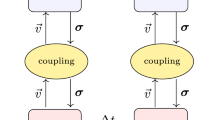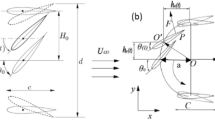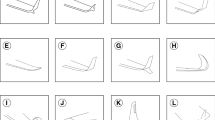Abstract
Flight feathers of birds interact with the air flow during flight. How the observed low drag and high lift values at wind speeds from 9.0 to 19.8 m/s can be achieved due to the feather aerodynamics remains unknown. In the present paper, we tested and compared morphological changes, drag reduction and flow visualization results of intact, damaged, and artificial feathers at different wind speeds in a wind tunnel. Through the analysis of the drag force and resultant force angle, we proved that the integrity of feathers, whose barbs are usually closely interconnected, played an important role in the drag, which potentially triggers excellent drag reduction performance. The wind tunnel tests indicated that intact secondary feathers had a surprisingly high maximum drag reduction property at v = 9 m/s compared with the feathers, where the integrity of barbs was damaged. The hook cascades facilitated elasticity under pressure and suitable permeability in an intact feather, when the hooks were interlocked. It was indicated that the suitable permeability of intact feathers would prevent flow separation and reduce drag force at low wind speed; at high wind speed, elasticity under pressure and suitable permeability in an intact feather would facilitate strong squeezing effect, helping feathers withstand larger aerodynamic forces to which they might be subjected during flight. It was revealed that the intact secondary feather is a compromise between strong lift generation and drag reduction, which has a great significance for the bird’s flight.













Similar content being viewed by others
Data Availability Statement
The datasets generated during or analyzed during the current study are available from the corresponding author on reasonable request.
References
Sun, J., & Dai, Z. D. (2013). Bionics of animal behaviors. Science Press.
Stowers, A. K., Matloff, L. Y., & Lentink, D. (2017). How pigeons couple three-dimensional elbow and wrist motion to morph their wings. Journal of the Royal Society Interface, 14, 20170224.
Muller, W., & Patone, G. (1998). Air transmissivity of feathers. Journal of Experimental Biology, 201, 2591–2599.
Inasawa, A., Mori, F., & Asai, M. (1971). Detailed observations of interactions of wingtip vortices in close-formation flight. Journal of Aircraft, 49, 206–213.
Chang, E., Matloff, L. Y., Stowers, A. K., & Lentink, D. (2020). Soft biohybrid morphing wings with feathers underactuated by wrist and finger motion. Science Robotics, 5, eaay1246.
Gu, Y. Q., Fan, T. X., Mou, J. G., Wu, D. H., Zheng, S. H., & Wang, E. (2017). Characteristics and mechanism investigation on drag reduction of oblique riblets. Journal of Central South University, 6, 159–166.
Shinichiro, I. T. O. (2009). Aerodynamic influence of leading edge serrations on an airfoil in a low Reynolds number. Journal of Biomechanical Science and Engineering, 4, 117–123.
Geyer, T., Sarradj, E., & Fritzsche, C. (2010). Measurement of the noise generation at the trailing edge of porous airfoils. Experiments in Fluids, 48, 291–308.
Geyer, T., Sarradj, E., & Fritzsche, C. (2013). Silent owl flight: Comparative acoustic wind tunnel measurements on prepared wings. Acta Acustica United with Acustica, 99, 139–153.
Sarradj, E., Fritzsche, C., & Geyer, T. (2011). Silent owl flight: Bird flyover noise measurement. AIAA Journal, 49, 769–779.
Borchers, I. U., Gruschka, H. D., & Coble, J. G. (1971). Aerodynamic noise produced by a gliding owl. Nature, 233, 409–411.
Sun, S. M., Ren, L. Q., & Xu, C. Y. (2008). Research on coupling sound absorption property of owl skin and feather. Noise and Vibration Control, 3, 119–223.
Chen, H. W., Rao, F. G., Shang, X. P., Zhang, D. Y., & Hagiwara, I. (2013). Biomimetic drag reduction study on herringbone riblets of bird feather. Journal of Bionic Engineering, 10, 341–349.
Kovalev, A., Filippov, A. E., & Gorb, S. N. (2014). Unzipping bird feathers. Journal of the Royal Society Interface, 11, 20130988.
Sullivan, T. N., Pissarenko, A., Herrera, S. A., Kisailus, D., Lubarda, V. A., & Meyers, M. A. (2016). A lightweight, biological structure with tailored stiffness: The feather vane. Acta Biomaterialia, 41, 27–39.
Zhang, C. C., Wu, Z. Y., Zhang, X. M., Yue, Y. L., & Wang, J. (2018). Effect of feather elasticity of kingfisher wing on droplet impact dynamics. Journal of Bionic Engineering, 15, 731–740.
Wang, B., & Meyers, M. A. (2017). Seagull feather shaft: Correlation between structure and mechanical response. Acta Biomaterialia, 48, 270–288.
Sullivan, T. N., Wang, B., Espinosa, H. D., & Meyers, M. A. (2017). Extreme lightweight structures: Avian feathers and bones. Materials Today, 20, 377–391.
Purslow, P., & Francis, J. V. V. (1978). Mechanical properties of primary feathers from the pigeon. Journal of Experimental Biology, 72, 251–260.
Eder, H., Fiedler, W., & Pascoe, X. (2011). Air-permeable hole-pattern and nose-droop control improve aerodynamic performance of primary feathers. Journal of Comparative Physiology A, 197, 109–117.
Chen, H. W., Rao, F. G., Zhang, D. Y., & Shang, X. P. (2013). Drag reduction study about bird feather herringbone riblets. Applied Mechanics and Materials, 461, 201–205.
Feng, B. B., Chen, D. R., Wang, J. D., & Yang, X. T. (2015). Bionic research on bird feather for drag reduction. Advances in Mechanical Engineering, 7, 849294.
Ennos, A. R., Hickson, J., & Roberts, A. (1995). Functional morphology of the vanes of the flight feathers of the pigeon Columba livia. Journal of Experimental Biology, 198, 1219–1228.
Worcester, S. E. (1996). The scaling of the size and stiffness of primary flight feathers. Journal of Zoology, 239, 609–624.
Tucker, V. A. (1993). Gliding birds: Reduction of induced drag by wing tip slots between the primary feathers. Journal of Experimental Biology, 180, 285–310.
Gao, J. L., Zhang, G. Q., Guan, L., Chu, J. K., Kong, D. Y., & Bi, Y. T. (2013). Structure and mechanical property of asio otus feather barbs. Key Engineering Materials, 562–565, 914–919.
Bachmann, T., Emmerlich, J., Baumgartner, W., Schneider, J. M., & Wagner, H. (2012). Flexural stiffness of feather shafts: Geometry rules over material properties. Journal of Experimental Biology, 215, 405–415.
Wang, X., Nudds, R. L., Palmer, C., & Dyke, G. J. (2012). Size scaling and stiffness of avian primary feathers: Implications for the flight of Mesozoic birds. Journal of Evolutionary Biology, 25, 547–555.
De La Hera, I., Hedenstrm, A., Pérez-Tris, J., & Tellería, J. L. (2010). Variation in the mechanical properties of flight feathers of the blackcap Sylvia atricapilla in relation to migration. Journal of Avian Biology, 41, 342–347.
Weber, T. P., Borgudd, J., Hedenström, A., Persson, K., & Sandberg, G. (2005). Resistance of flight feathers to mechanical fatigue covaries with moult strategy in two warbler species. Biology Letters, 1, 27–30.
Wainwright, S. A., Biggs, W. D., Currey, J. D., & Gosline, J. M. (1976). Mechanical design in organisms. Princeton University Press.
Combes, S. A., & Daniel, T. L. (2003). Flexural stiffness in insect wings I. Scaling and the influence of wing venation. Journal of Experimental Biology, 206, 2979–2987.
Walker, S. M., Thomas, A., & Taylor, G. K. (2009). Deformable wing kinematics in the desert locust: How and why do camber, twist and topography vary through the stroke? Journal of the Royal Society Interface, 6, 735–747.
Young, J., Walker, S. M., Bomphrey, R. J., Taylor, G. K., & Thomas, A. L. R. (2009). Details of insect wing design and deformation enhance aerodynamic function and flight efficiency. Science, 325, 1549–1552.
Corning, W. R., & Biewener, A. A. (1998). In vivo strains in pigeon flight feather shafts: Implications for structural design. Journal of Experimental Biology, 201, 3057–3065.
Liu, Z. Q., Jiao, D., Meyers, M. A., & Zhang, Z. F. (2015). Structure and mechanical properties of naturally occurring lightweight foam-filled cylinder – the peacock’s tail coverts shaft and its components. Acta Biomaterialia, 17, 137–151.
Bechert, D. W., Bruse, M., Hage, W., & Meyer, R. (1997). Biological surfaces and their technological application-laboratory and flight experiments on drag reduction and separation control. In 4th AIAA shear flow conference, Snowmass Village.
Zhang, S., Ochiai, M., Sunami, Y., & Hashimoto, H. (2019). Influence of microstructures on aerodynamic characteristics for dragonfly wing in gliding flight. Journal of Bionic Engineering, 16, 423–431.
Rouméas, M., Gilliéron, P., & Kourta, A. (2009). Drag reduction by flow separation control on a car after body. International Journal for Numerical Methods in Fluids, 60, 1222–1240.
Choi, J., Jeon, W. P., & Choi, H. (2006). Mechanism of drag reduction by dimples on a sphere. Physics of Fluids, 18, 041702.
Yan, X., Ye, J., Zhao, Z. M., Hu, X. J., & Liao, L. (2011). Effect of vortex generators on aerodynamic characteristics of a car. Advanced Materials Research, 418–420, 1873–1877.
Selig, M. S., Donovan, J. F., & Fraser, D. B. (1989). Airfoils at low speeds. Stokely.
Simpson, S. F. (1983). The flight mechanism of the pigeon Columbia livia during take-off. Journal of Zoology, 200, 435–443.
Dial, K. P. (2003). Wing-assisted incline running and the evolution of flight. Science, 299, 402–404.
Berg, A. M., & Biewener, A. A. (2010). Wing and body kinematics of takeoff and landing flight in the pigeon (columba livia). Journal of Experimental Biology, 213, 1651–1658.
Acknowledgements
This work was supported by the Chinesisch-Deutsches Zentrum für Wissenschaftsförderung to SNG and ZDD (Grant No. GZ1154); and the National Natural Science Foundation of China (Grant Nos. 51875281, 51861135306). This study was carried out in accordance with the Guide for Laboratory Animal Management Ordinance of China. The experimental procedures were approved by the Jiangsu Association for Animal Science (Jiangsu, China). The authors thank Guodong Qin and Xiyuan Zhang for their help with the experimental setup. We acknowledge the advice of the editor and reviewers who helped in improving the early version of the manuscript.
Author information
Authors and Affiliations
Contributions
All authors contributed to the study conception and design. The experimental setup was designed by QL, HS and QH. Material preparation, data collection, and analysis were performed by QL and HS. The first draft of the manuscript was written by QL. AJ, ZD and SNG contributed to data interpretation and critically revised the manuscript. All authors approve the final version of the manuscript for publication and agree to be held accountable for the work performed therein.
Corresponding author
Ethics declarations
Conflict of interest
The authors declare that they have no conflicts of interest.
Additional information
Publisher's Note
Springer Nature remains neutral with regard to jurisdictional claims in published maps and institutional affiliations.
Supplementary Information
Below is the link to the electronic supplementary material.
Rights and permissions
About this article
Cite this article
Li, Q., Shen, H., Han, Q. et al. Effects of Morphological Integrity of Secondary Feather on Their Drag Reduction in Pigeons. J Bionic Eng 19, 1422–1438 (2022). https://doi.org/10.1007/s42235-022-00203-2
Received:
Revised:
Accepted:
Published:
Issue Date:
DOI: https://doi.org/10.1007/s42235-022-00203-2




